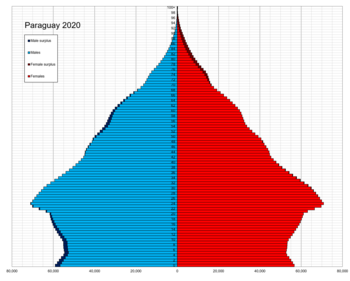Our website is made possible by displaying online advertisements to our visitors.
Please consider supporting us by disabling your ad blocker.
Demographics of Paraguay
| Demographics of Paraguay | |
|---|---|
 Population pyramid of Paraguay in 2020 | |
| Population | 6,109,644 (2022 census)[1] |
| Growth rate | 0.71% (2024)[1] |
| Birth rate | 16.32 births/1,000 population (2022 est.) |
| Death rate | 4.87 deaths/1,000 population (2022 est.) |
| Life expectancy | 78.37 years |
| Fertility rate | 1.95 children born/woman (2024)[1] |
| Infant mortality rate | 14.4 deaths/1,000 live births |
| Net migration rate | -0.07 migrant(s)/1,000 population (2022 est.) |
| Age structure | |
| 0–14 years | 25.4% |
| 15–64 years | 66.3% |
| 65 and over | 8.3% |
| Nationality | |
| Nationality | Paraguayan |
| Major ethnic |
|
| Minor ethnic |
|
| Language | |
| Official | Spanish and Guarani |
| Spoken | Languages of Paraguay |
Paraguay's population is distributed unevenly through the country. The vast majority of the people live in the eastern region, most within 160 kilometres (99 mi) of Asunción, the capital and largest city, which borders on Argentina to the south and west. The Gran Chaco in the north-west, which accounts for about 60% of Paraguayan territory, is home to less than 4% of the population.
Ethnically, culturally, and socially, Paraguay has one of the most homogeneous populations in South America. About 75% of the people are mestizo (mixed Spanish and Guaraní Native American descent), 20% are Whites, and the rest are small minorities of Indigenous or Afro Paraguayan origin.[4] Little trace is left of the original Guaraní culture except the language, which is spoken by 90% of the population. About 75% of all Paraguayans also speak Spanish. Guaraní and Spanish are official languages.
Paraguay has a history of foreign settlement, especially in the 20th century: Germans (the majority are Mennonites) with long-time Paraguayan dictator Alfredo Stroessner (President, 1954–1989) himself of German ancestry; Italians (around 40% of the total Paraguayan population is of full or partial Italian descent);[5][6][7] Japanese with Okinawans; Koreans; Chinese; Arabs, Ukrainians; Poles; Southern Europeans; Jews; Brazilians; and Argentines are among those who have settled in Paraguay. There are also an estimated 234,000 Afro-Paraguayans, or 4% of the population.[8]
European and Middle Eastern immigrants began making their way to Paraguay in the decades following the Paraguayan War of 1864–1870 (from 1870 onward). Only 28,000 men and 200,000 women had survived the war, the reason why Paraguay had since then a high rate of illegitimate births. The government pursued a pro-immigration policy in an effort to increase population. Government records indicated that approximately 12,000 immigrants entered the port of Asunción between 1882 and 1907, of whom almost 9,000 came from Italy, Germany, France, and Spain. Migrants also arrived from neighboring Spanish American countries, especially Argentina. The immigrant ethnic groups kept their cultures and languages to some extent, especially Brazilians – known as "Brasiguayos".[9][10]
Official records gave an imprecise sense of the number of Brazilians who came to the country. According to the 1982 census, 99,000 Brazilians resided in Paraguay. Most[quantify] analysts discounted this figure, however, and contended that between 300,000 and 350,000 Brazilians lived in the eastern border region.
Analysts also rejected government figures on the number of immigrants from South Korea, Hong Kong and Taiwan. The 1982 census reported that there were 2,700 Koreans in Paraguay, along with another 1,100 non-Japanese or non-Korean Asian immigrants. Virtually all Koreans and Chinese lived in Ciudad del Este or Asunción and played a major role in the importation and sale of electronic goods manufactured in Asia.
Paraguay became the site of radical and progressive colonies inspired by political thinkers of the late 19th and early 20th centuries. A group of radical socialist Australians in the 1890s voluntarily went to create a failed master-planned community, known as Nueva (New) Australia (1893 -1897); and Elisabeth Nietzsche, a German racial ideologist and sister of philosopher Friedrich Nietzsche came to Paraguay in her attempt to build a colony, Nueva Germania (Neues Deutschland) (founded 1886) devoted to a hypothetical pure white "Nordic" society.
A 2022 census found that Paraguay's population shrank as a production of migration and having smaller families, as well as better data integrity, resulting in a loss of over one million.[11]
- ^ a b c "Paraguay: Estimated population, 2024–2050" (PDF). INE Paraguay (in Spanish). 3 January 2025.
- ^ "Censo Indígena 2022 – INE" (PDF). Instituto Nacional de Estadística – Paraguay. Retrieved 9 September 2023.
- ^ "Editorial".
- ^ Francisco Lizcano Fernández (2005). "Composición Étnica de las Tres Áreas Culturales del Continente Americano al Comienzo del Siglo XXI" [Ethnic Composition of the Three Cultural Areas of the American Continent at the Beginning of the 21st Century]. Convergencia. Revista de Ciencias Sociales (in Spanish). 12 (38): 185–232.
- ^ "Italianos en el Paraguay elegirán representantes" (in Spanish). 1 December 2014. Archived from the original on 31 March 2019. Retrieved 17 December 2018.
- ^ "Los italianos y su aporte a la nación – Articulos – ABC Color".
- ^ "Ya se puede sacar la nacionalidad italiana" (in Spanish). Retrieved 29 May 2020.
- ^ "Afro-Latino: A deeply rooted identity among U.S. Hispanics". March 2016.
- ^ Hilton, Ronald (15 June 2001). "BRAZIL: Brazilians in Paraguay". Retrieved 19 January 2017.
- ^ "Culture of Paraguay – history, people, clothing, traditions, women, beliefs, food, customs, family". www.everyculture.com. Retrieved 19 January 2017.
- ^ "Over a million Paraguayans disappear in the latest census". The Americas. The Economist. 6 October 2023. Retrieved 15 November 2023.
Previous Page Next Page


